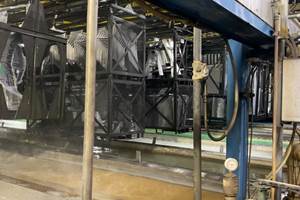How to Mask Common Part Features for Liquid and Powder Coating
Q. Could give us some tips on making sure we are using the proper masking tools for our parts. Masking expert Andrew Oniszczuk from EPSi answers this reader’s question.
Q. We perform a lot of masking at our liquid and powder coating shop, and I wondered if you could give us some tips on making sure we are using the proper masking tools for our parts.
A. It’s part of the last step of manufacturing and the finishing industry’s best friend. It keeps wet paint spray or powder coat out of critical geometry such as threaded holes or surfaces that will receive a second finishing operation. Without masking, the last step of the manufacturing process would take longer and become much more difficult. Painted threads would have to be cleaned out. Critical coated surfaces would need to be scrubbed, buffed, or ground free of paint or powder coat.
In short, good masking saves money. Better masking saves even more money. The question is: Are you using the right method and saving the most you could?
Through-holes—threaded or not—are the most common geometry that requires masking, and they are usually effectively masked with silicone pull plugs. The pull plug is smaller in diameter so that it can be threaded through the hole and used as a handle. Once the pulling begins, the diameter of the silicone body shrinks down and makes pulling the plug into the hole easier. Once the pulling stops, the diameter of the plug body snaps back to its original size and pushes against the threads or the inside wall of the hole.
Masking off blind holes—threaded or not—is an entirely different thing. Tapered silicone stoppers are frequently used to mask blind holes. However, if the hole is deep enough, the heat of the curing process can build up the air pressure in the hole and pop the tapered stopper out. A better way to mask blind holes is using silicone plugs with straight side walls that engage with the thread or inside wall of the hole. Such plugs usually have a small washer around them to stop paint or powder from building up around the chamfer and thread lead of a threaded blind hole. In a pinch, when you don’t have a stopper or plug handy, an inverted silicone cap can be pushed into the blind hole with a pencil. This makes an ideal mask in that it covers the threads and allows no air volume to build up behind the cap.
Studs, such as PEM studs installed on sheet metal used in the electronics industry, also commonly need masking. Or perhaps you have a plain hinge or pivot point on a part. Silicone caps are best for masking these kinds of features. When installing standard caps over threaded studs becomes difficult, you can try special caps made with an internal bead (or lip) that contacts the outside of the threads while the rest of the body stands off of the threads. Any buildup in air pressure can be vented through a special vent in the cap. Electronics manufacturers that use threaded PEM studs for grounding on their sheet metal forms can use a silicone cap with a washer around the base to keep the area around the stud free of finish so that it can be used as a ground.
Like PEM studs, weld nuts are frequently used in cases where threaded through-holes won’t work. Appropriate for masking such features are special silicone plugs that either can be pulled through the weld nut or pushed in from one direction. These plugs will mask not just the threads of the weld nut, but the area on both sides.
Larger flat areas on surfaces, such as flanges, edges or recessed areas, can be masked off with tape. The two most important criteria for tape is heat resistance and flexibility. It must be able to survive the powder coat or wet-spray curing process, which usually takes place at about 500°F, but it also must be able to conform to irregular surfaces. Tape comes in rolls, but it can also be cut into custom shapes that can then be peeled off of a plastic liner and applied to an area requiring masking.
About the Author
Andrew Oniszczuk
Andrew Oniszczuk is a product engineer with EPSI.
Related Content
Anodizing for Bonding Applications in Aerospace
Anodizing for pre-prep bonding bridges the gap between metallic and composite worlds, as it provides a superior surface in many applications on aluminum components for bonding to these composites.
Read MoreConveyors and Paint Systems
Choosing the right conveyor system, coating technology, and ancillary equipment.
Read MoreAn Overview of Electroless Nickel Plating
By definition, electroless plating is metal deposition by a controlled chemical reaction.
Read MoreInstalling an Ecoat Line
Thinking of investing in electrocoating capabilities? George Lovell, coatings plant manager for Lippert, discusses considerations you should keep in mind as you add your ecoat line.
Read MoreRead Next
Episode 45: An Interview with Chandler Mancuso, MacDermid Envio Solutions
Chandler Mancuso, technical director with MacDermid Envio discusses updating your wastewater treatment system and implementing materials recycling solutions to increase efficiencies, control costs and reduce environmental impact.
Read MoreEducation Bringing Cleaning to Machining
Debuting new speakers and cleaning technology content during this half-day workshop co-located with IMTS 2024.
Read MoreA ‘Clean’ Agenda Offers Unique Presentations in Chicago
The 2024 Parts Cleaning Conference, co-located with the International Manufacturing Technology Show, includes presentations by several speakers who are new to the conference and topics that have not been covered in past editions of this event.
Read More











.jpg;maxWidth=300;quality=90)












